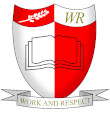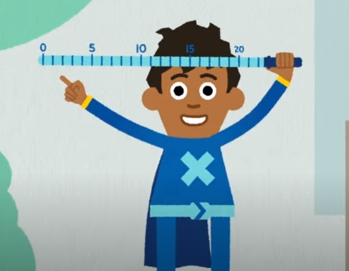Here are some suggestions for next week’s Home Learning. Again, please don’t feel under pressure to complete all the work we set. Some of you will have more time than others and some will be learning in different ways. Contact us by email if you have any questions and thank you – you’re all doing an amazing job.
l.thorn@wransom.herts.sch.uks.kholodenko@wransom.herts.sch.uk
a.morris@wransom.herts.sch.uk
Follow us on Twitter @YearOneWR
This is a useful book which may be helpful to share with any children struggling with the lockdown. https://issuu.com/sophie_marsh/docs/stay_home_superheroes/1?ff
Maths – Multiplication
Again please work through at your child’s own pace. Start with the first task, and as your child becomes confident with that, then move on to the next one.
For extra practise or to consolidate their learning, there are worksheets to download and work through for each step and some extension questions at the end.
- Count in multiples of 2 forwards and backwards.
- Find some socks and count the number of socks. Then write: There are __ socks altogether.
- Pair the socks up. Then write: There are __ socks in each pair. There are __ pairs of socks.
- How many equal groups of 2 are there?
- Now copy and complete this chart.
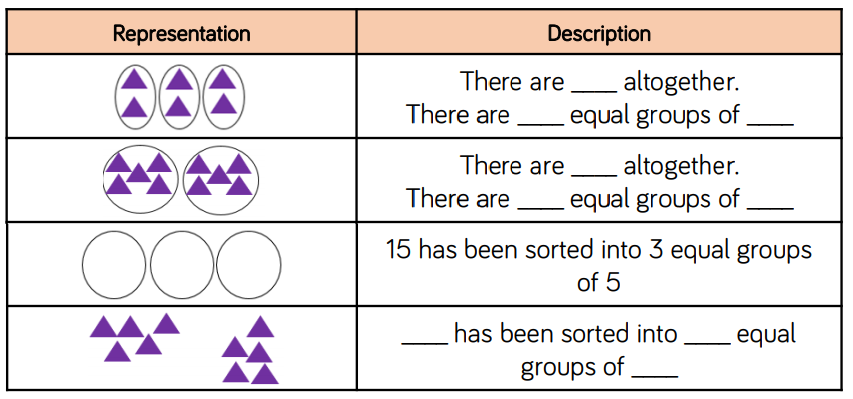
- For further practise making equal groups you can download this worksheet.
- Now practise counting in multiples of 5 forwards and backwards.
- Instead of saying 2 groups of 5 we can use the multiplication symbol x
Watch the clip as Multiplication Boy explains
https://www.youtube.com/watch?v=0b9Tta4jeVI - Practise writing the X symbol. You can make an X with your arms too.
- Write out your 2 times table e.g. 1 x 2 = 2, 2 x 2 = 4, 3 x 2 = 6 etc.
- Write out your 5 times table e.g. 1 x 5 = 5, 2 x 5 = 10, 3 x 5 = 15 etc.
- Write out your 10 times table e.g. 1 x 10 = 10, 2 x 10 = 20, 3 x 10 = 30 etc.
- You can practise your times tables using this link
https://www.topmarks.co.uk/maths-games/mental-maths-train - Now have a go at drawing arrays and writing the multiplication number sentence:
- Next see if you can find some 2p coins in your piggy bank (or ask an adult). Select an amount and write as an addition number sentence. Then as a multiplication number sentence. (See above)
- Repeat for a different number of 2p coins.
- Then find some 5p coins and repeat.
- Then find some 10p coins and repeat.
- For further practise complete the sheet below.
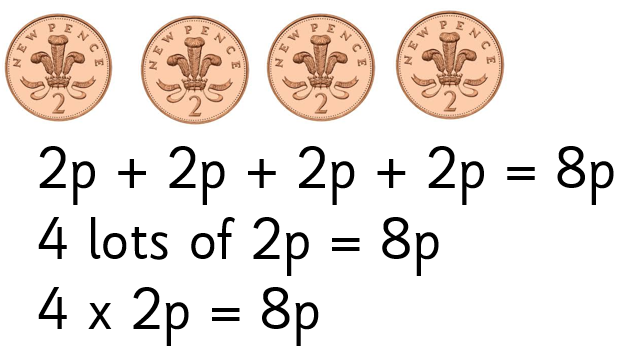
- Did you notice that times tables can be written either way round and the answer stays the same – just like addition? E.G. 2 x 10 = 20 and 10 x 2 = 20
- Watch this clip as Multiplication Boy explains:
https://www.youtube.com/watch?v=XOyOVDMjUdo - To push your learning on further, try these extension questions:
English – Phonics
Group 1: This week’s sound is the split diagraph ‘a-e’ as in snake.
- Practise writing these words with the ‘a-e’ sound: game, cake, spade, whale, made, bake. Perhaps have a go at drawing a picture for the words and label them.
- Play Buried Treasure on www.phonicsplay.co.uk. Click on the link for free phonics play, parents, phase 5, buried treasure and then on our sound of the week.
- What other ways are there of spelling the ‘a-e’ sound? (ai, ay, eigh, ey, ei) Write all the options along the top of a page and see how many words you can come up with for each spelling.
- Choose a word with the ‘a-e’ sound and spelling and write a sentence with that word in it.
Group 2: This week’s sound is ‘air’ as in chair.
- Practise writing these words with the ‘air’ sound: chair, fair, pair, fairy, hair.
- Play Buried Treasure on www.phonicsplay.co.uk. Click on the link for free phonics play, parents, phase 3, buried treasure and then on our sound of the week.
- Choose a word with the ‘air’ sound and write a sentence with that word in it.
- Practise writing the following capital letters and lower case letters: Tt, Uu, Vv, Ww, Xx, Yy, Zz
English – Poetry and Flying
This week’s learning is on poetry and all based around flying and flight
Activity 1: Poetry
Read the poem below. It is based on a poem written by Margaret Wise Brown but Mrs Kholodenko has rewritten it so that it is just about birds.
Who saw the bee
fly onto the rose?
I, said the sparrow,
but nobody knows.
Who saw the cat
stretching as it purred?
I, said the robin,
but nobody heard.
Who saw the fog
come over the sea?
I, said the pigeon,
only me.
Who saw the first
green light of the sun?
I, said the night owl,
the only one.
Who saw the moss
creep over the stone?
I, said the eagle,
all alone.
- When a poem is divided into sections the sections are called stanzas. How many stanzas does the poem have?
- Notice how there is a question and answer in each section. What do the questions start and end with? (capital letter and question mark) What do the answers start and end with? (capital letter and full stop)
- What else do you notice about the poem? (Rhymes, sentences are split between lines) Do you like the poem? Why?
Think about all the things a bird is able to see from the sky. Can you write your own poem following the pattern of Mrs Kholodenko’s? Each stanza will start “Who saw…” and then you can make up anything. E.g. “Who saw the dog pick up the stick?”. Or “Who saw the boy steal a cake?” You can make up anything a bird might see from the sky! And then have your answer follow the same pattern: “I, said the….” Choose a different bird each time and then try to make it rhyme with the last word of your question. Before you know it you’ll have written your very own poem!
Activity 2
Some poems are silly and don’t always make lots of sense. Watch the video of a boy performing a silly poem called Flying Lessons.
Silly poems can make us laugh and make us feel good. Can you learn the words of the poem in the video and perform it? What actions might you make for each line? This may take you several days to perfect!
Activity 3
Can you find any other poems about flying or flight? Read them with an adult if you find any. Do you like any of them? Which is your favourite? Copy out your favourite and illustrate it.
English – Grammar task: adding s or es
List of words to use in sentences in the singular and plural with the correct plural spelling. There are lots of words so you could make a table with -s and -es as the headings and write the words in the correct column and then choose 2 or 3 to write sentences for.
Kiss, Dog, Fish, Church, Cat, Chip, Box, Dish, Class, Witch, Bush
Science – Labelling Plants
This week we will look more closely at the parts of a plant.
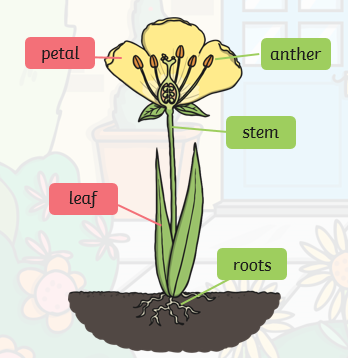
Can you draw a plant from your garden and label the different parts?
Now draw a tree and see if you can label the parts. What do we call the stem on a tree? Does the tree have fruit on it? What does it look like?
The different parts of the plant do different jobs.
Petals attract insects to the plant. Plants need insects to bring pollen they have collected from other flowers so they can make seeds. Petals are bright colours to attract the insects.
Leaves make food for the plant from carbon dioxide in the air and sunlight.
Roots absorb minerals and water from the soil. The roots also help the plant anchor in the soil and stay upright.
The stem transports water around the plant. It also holds the plant upright so it can get more sunlight.
The anther contains pollen which brushes onto insects when they land on the flower. The pollen is moved by insects to other flowers
Watch this clip of tulips over a day. Why do you think they move?
History – Design a paper aeroplane
Although the Wright Brothers were the first ever recorded flight, a man called Otto Lilienthal was the first man to fly in 1894 but no-one filmed it. They did, however, have photography then and recently a man put together all of the photographs to make it look like a film.
Otto Lilienthal looked at the flight of birds and adapted the wings slightly each time he tried down the same hill.
Do you think it is an easy task to build an aeroplane?
Try to make a paper aeroplane of your own. You could try different designs and measure how far each one goes. You could decorate them too.
Here’s one to get you started. Or watch the video of Mrs Morris in the Art section below.
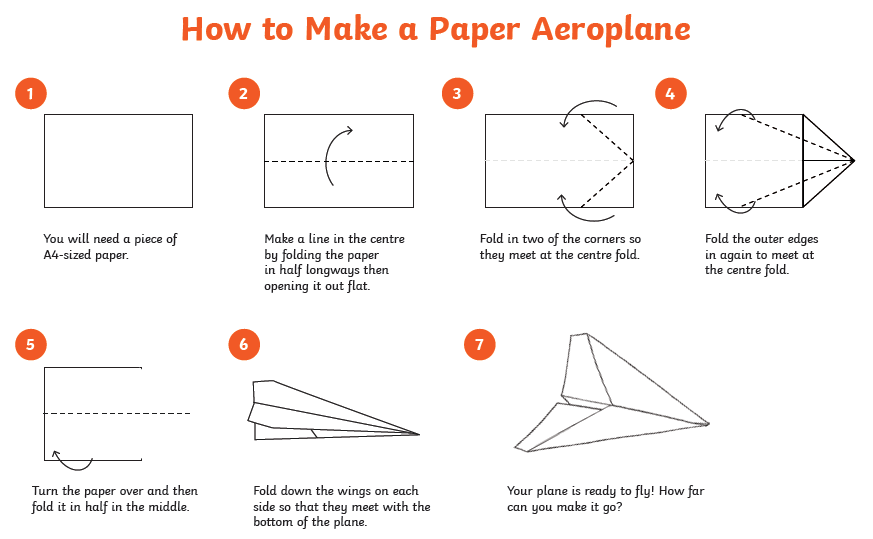
Art – Flying superheroes
For this week’s art we would like you to make your own flying superhero.
Please watch the video from Mrs Morris.
You’ll also need this link to The British Library.
https://www.bl.uk/childrens-books/activities/what-makes-a-hero-super
Have fun!
Geography
For this week’s Geography task please see the letter from The Tooth Fairy!
